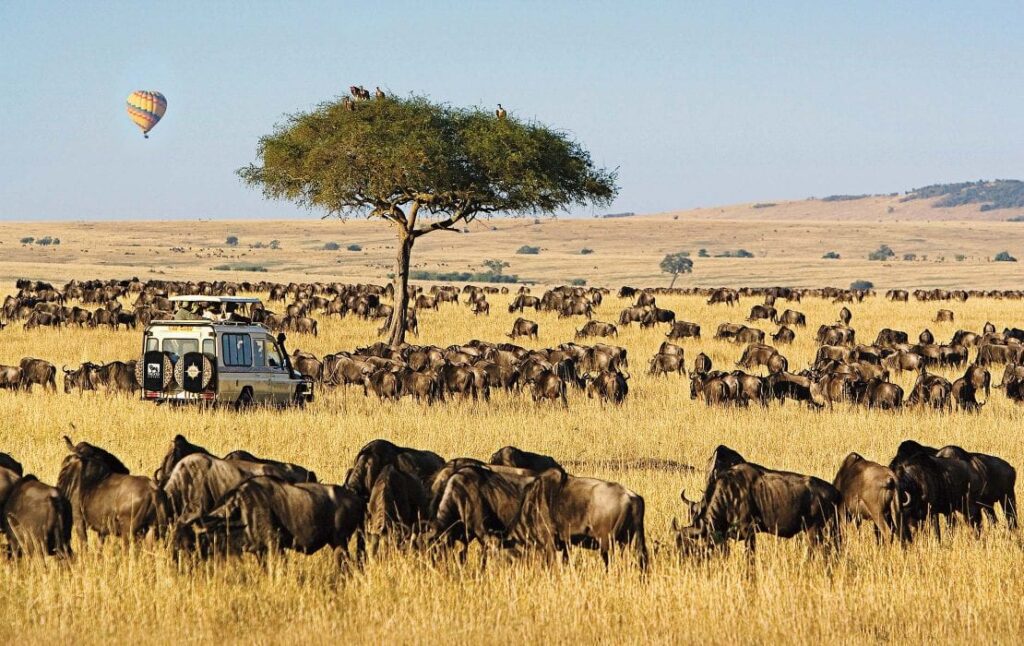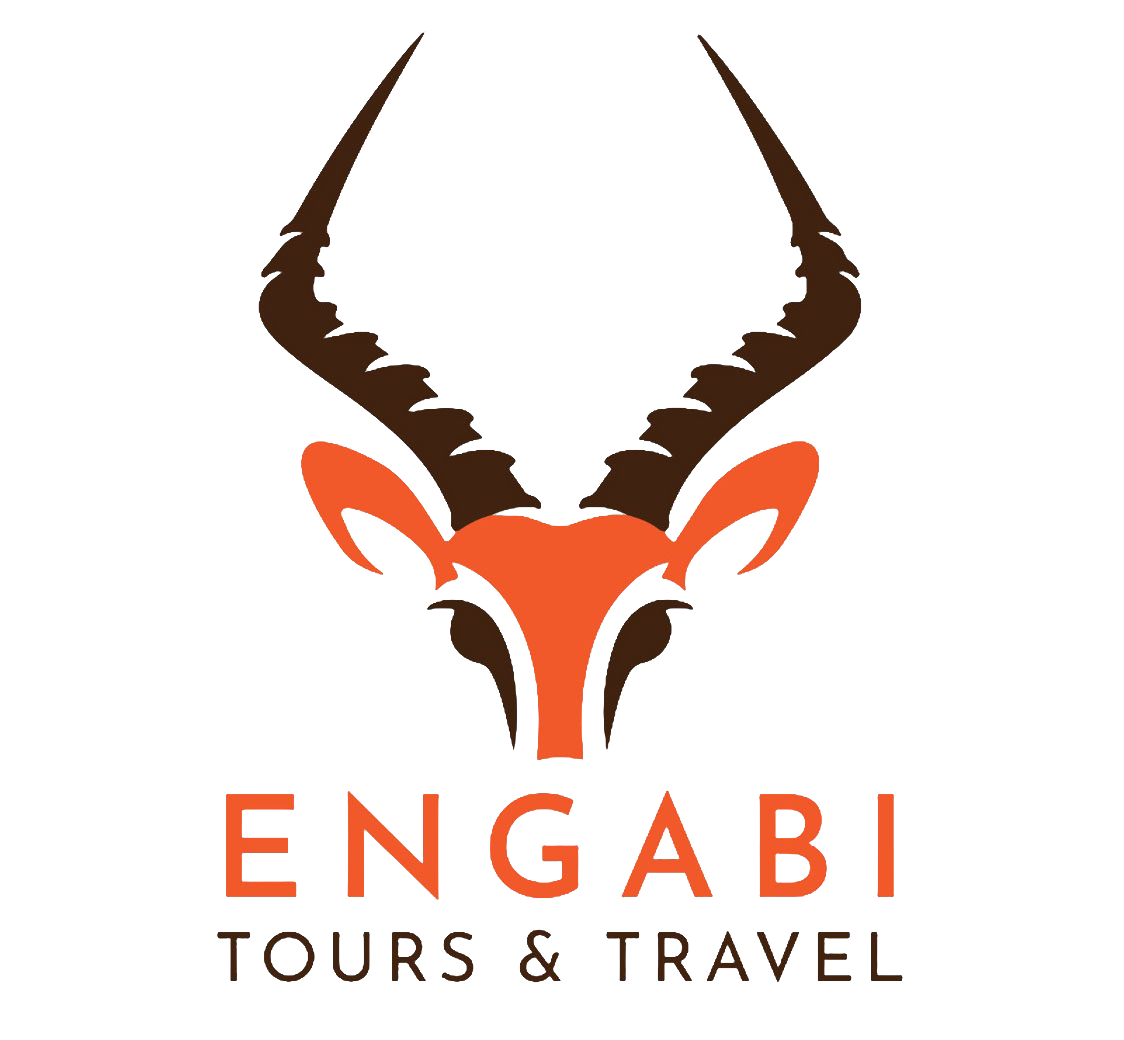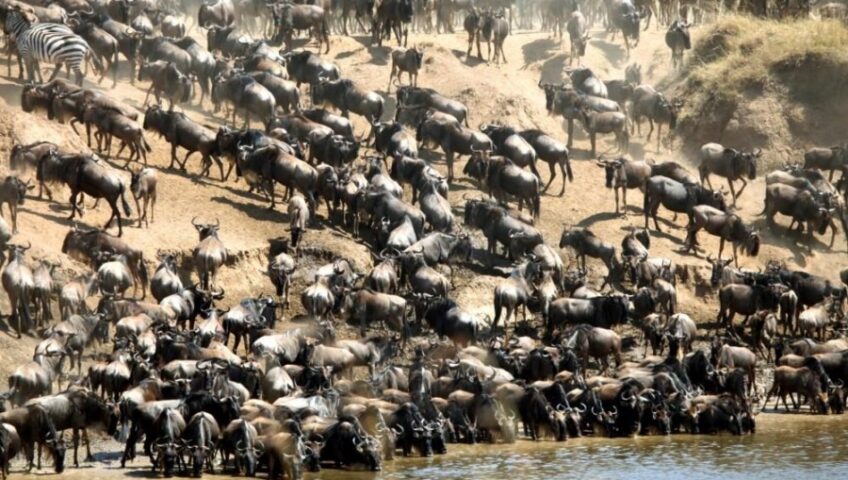One of nature’s most iconic vistas, the Maasai Mara National Reserve is unquestionably a must-visit location for tourists. Additionally, it is one of the most well-known wilderness and wildlife conservation areas in Africa, let alone the entire continent, due to its exceptional population of the big five, including lions, African leopards, African bush elephants, African buffaloes, black and white rhinoceros, cheetahs, over 500 bird species, and many others that travel with the magnificent great migration of the wildebeest from the Serengeti plains to the Mara reserve. However, Nairobi, Kenya’s primary capital city, is only 180 kilometers distant from the reserve, which is situated in south-western Kenya on the edge of the rift valley.
The word Masaai was derived from the Masaai people, who are the country’s original residents and who migrated all the way from the Nile Basin and whose description area is now the Maasai people of Kenya. The Maasai Mara National Reserve is also known as a large game reserve, not just in Kenya but also throughout the world. This Maasai community is spread out over southern Kenya, northern, central, and northern Tanzania.
NOTE: This protected area is referred to with pride as Maasai Mara and locally as “the Mara,” which is Maasai for “spotted circles.” And this is because the area’s surroundings are covered with many short, bushy trees.
The National Reserve is really humbled to host one of the great wildebeest migrations, which is recognized as one of the ten natural wonders of the world and one of the seven natural wonders of Africa, and makes the Reserve well-known throughout the world. The great migration is one of the most important natural events in the world, attracting millions of tourists who come to have an extraordinary once-in-a-lifetime experience and see nearly 1,300,000 blue wildebeest from above. To be aware of, the greatest time to visit the Maasai Mara National Reserve for the magnificent wildebeest migration is from July to October each year.
Maasai Mara National Reserve used to occupy an area of over 520 square kilometers, including the Mara Triangle, before it was first established in 1961 as a wildlife refuge. Later, in late 1961, the area was expanded to the east, totaling a square kilometer and 1821 acres, and it was turned into a game reserve. The Narok County Council served as the reserve’s administrative body during that particular period in 1961. The reserve was accorded national status in 1974, and the remaining area—about 159 square kilometers—was given back to the maasai people and neighboring communities. Additionally, between 1976 and 1984, a total of 162 square kilometers of land were taken out of the reserve, bringing the total down to 1,510 square kilometers.
The Trans Mara County Council, sometimes known as the “TMCC,” was established in the western portion of the reserve in 1994. As a result, the management of the reserve is now split between the new council and the previous Narok County Council. Previously, the park was under the control of the Narok County Council. Keep in mind that the Mara Conservancy, a non-profit organization run by the Mara Triangle, was established in May 2001.
Fortunately, the Maasai Mara National Reserve, with its exceptional great wildebeest migration and expansive size that safeguards one of the largest populations of wild animals in Africa, is renowned as the top tourist destination in that continent.
The top wildlife and natural attractions in Maasai Mara National Reserve are found both inside and beyond the reserve. Examples of these attractions include;
One wouldn’t attempt to participate in the remarkable annual wildebeest migration, which is the largest animal migration in the world.
OI Kinyei Conservancy
This conservancy, which is located in the middle of the reserve on the edge of the Serengeti-Mara ecosystem, is one of the main attractions in the Maasai Mara. The conservation offers breathtaking views of the reserve’s rolling kopjes.
Narok Museum
We urge visitors to include this experience in every Maasai Mara tour package they choose. One of the magnificent sights in this little town where visitors may view Kenyan traditional architecture and maasai culture clothing is the Narok Museum, which is located in the main town of Narok.
The Maasai Mara National Reserve also offers a wide range of exciting activities that visitors can engage in to have a wonderful, unforgettable experience that may even entice them to return for more adventure. These off-the-beaten-path activities include horseback safaris, game drives, and nature hikes.
Game drive
This is one of the most spectacular things to do in the Maasai Mara National Reserve because it is home to over 95 different kinds of mammals. Visitors may take a 4×4 safari vehicle up close to see the wild creatures while also adhering to park rules.Elephants, impalas, coke’s hartebeest, jackals, duikers, cheetahs, servals, and elephants are just a few of the wildlife that can be seen.In this reserve, there are three different times for game drives: morning (6:30 am to 10:30 am), evening (4:30 pm to 6:30 pm), and night (6:30 pm to 7:30 pm). All three times must be strictly followed by an armed guide.As a traveler, it is up to you to decide which option will work best for you.
Nature walks
Due to its vastness and ability to preserve one of the greatest populations in Africa, Maasai Mara is endowed with nature. Here, you may discover much more of the natural world both inside and outside the park.The local community looks after the reserve, providing visitors more opportunities to discover its hidden elements that would be missed during a game drive.Expect to see a variety of creatures up close during your nature walk activities, including elephants, giraffes, antelopes, buffalo, grazers, and birds of the air. You may also be able to approach the Mara River and have an unforgettable experience.
Hot air balloon safari
It can take 1 to 2 hours to enjoy the great aerial view of a herd of wildebeest that migrate into the reserve’s wildlife, the rift valley, and many other sights. This is an incredibly amazing experience that begins early in the morning. The ranger gives you instructions on how to start up, and you sit down inside the air balloon.

Horse riding safari
The finest way to discover the Maasai Mara landscape, wildlife trails, and fresh air of nature is with a horseback riding safari. When the migratory experience is in full swing, it goes above and beyond what you would have anticipated, and a certified game ranger conducts this activity.
Culture encounter
One of the largest cultures in Africa, the maasai, which are known as pastorists in the nation, surround the reserve. Travelers can witness the maasai people’s distinctive traditional attire, rules, and practices and return home with a memorable African traditional experience to tell the rest of their stories.
Bird viewing
The Maasai Mara National Reserve is renowned for housing approximately 500 bird species, 60 of which are raptors and some of which migrate.Vultures, Marabou’s storks, Secretary Birds, Ostriches, Long-Crowned Eagles, African Pygmy Falcons, Horn Bills, Crown Cranes, Secretary Birds, Sooty Chat, Tawny Eagle, Kori Bustard, and Kenyan National Bird are just a few of the species on the list.
Wildebeest migration viewing
One of the most exciting and rewarding wildlife viewing experiences in the world is seeing wildebeests migrate between two national parks. They can spend two to three months in Maasai Mara before moving on to Tanzania’s Serengeti National Park. Millions of tourists gather to Maasai Mara during this activity from July to October in order to witness an annual wildebeest migration in person.
Best time to visit Maasai Mara
The Maasai Mara National Reserve is best visited every year, even though there are two distinct seasons—dry and wet—and the best time to travel is during the reserve’s peak season, which lasts from July to October, when the wildebeest migration takes place. The greatest time to enjoy rewarding wildlife viewing and other park activities is from early November to early February.
Where to stay while in Maasai Mara National Reserve
A visitor to the Maasai Mara shouldn’t worry about where to stay because the reserve boasts a wide range of comfortable lodging options with good amenities, professional chefs, and more. Accommodations range from luxury to mid-range and can be booked with the assistance of a reliable tour operator.You can contact us at Achieve global safaris for more information about the reserve, and if you don’t mind, we can arrange all of your tour booking reservations, including booking your hotel room, Maasai Mara tour packages, and transportation by air or road from your pick-up to Jomo Kenyatta International Airport or from Uganda Entebbe International Airport.A few examples of these lodging options are Kilima Camp, Kichwa Tembo, Mpata Club, Naibor camps, Sentinel Mara camp, Enkewa camp, Mara Bush Camp, and numerous others.There is ample room for you to set up camp in your own tent as well.
Finally, I would advise anyone considering a trip to an African country to make sure they visit Maasai Mara National Reserve, which is home to one of the world’s top ten natural wonders, the annual migration of millions of blue wildebeest, which has made Kenya a popular tourist destination worldwide.Be aware that there are numerous other beautiful and gratifying activities that are done, like admiring the reserve’s beautiful landscape.Book today to learn more about Kenya, Africa’s historical natural gift.


